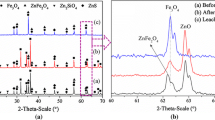Abstract
The main goal of this study was to recover the cadmium and nickel content of waste zinc filter cake. In this regard, at first, the dissolution of these elements in sulfuric acid and optimization of the solution process were considered. Effects of various parameters such as dissolution reaction time (10–40 min), temperature (25–80°C), sulfuric acid concentration (2–11 vol.%), and particle size distribution (four size fractions) under liquid/solid ratio of 10 and stirring speed of 600 rpm on leaching of Cd dissolution from Cd–Ni filter cake were evaluated and optimized by Taguchi method. The experimental plan was designed using an orthogonal array, L16 (44), which denotes four parameters with four levels. The optimum dissolution conditions proposed by the Design Expert software were a reaction time of 40 min, temperature of 80 °C, sulfuric acid concentration of 8 vol.%, and particle size distribution of −75 + 53 µm with predicted dissolution content of Cd equals to 93.15% by the software. In the optimum condition, 95.2% of the Cd content was leached during the verifying test. According to the results, reaction time, particle size distribution, acid concentration, and temperature are the most affecting parameters on Cd dissolution, respectively. Separation of Ni and Cd present in the solution after dissolution using sodium sulfate precipitation in the pH range of 1–5 was studied at the second stage, and the results show that at pH = 3, maximum separation of Ni and Cd (with weight ratio of Cd to Ni in the precipitates equals to 46.2) was achieved.
Graphical abstract













Similar content being viewed by others
References
Aparajith B, Kumar A, Hodder D, Gupta ML (2010) Recovery of cadmium from hydrometallurgical zinc smelter by selective leaching. Hydrometallurgy 102:31–36
Çopur M, Özmetin C, Özmetin E, Kocakerim MM (2004) Optimization study of the leaching of roasted zinc sulphide concentrate with sulphuric acid solutions. Chem Eng Process: Process Intens 43:1007–1014
Dürešová Z, Šuňovská A, Horník M, Pipíška M, Gubišová M, Gubiš M, Hostin J, Hostin S (2014) Rhizofiltration potential of Arundo donax for cadmium and zinc removal from contaminated wastewater. Chem Pap 68:1452–1462
Ennaassia E, Kacemi KE, Kossir A, Cote G (2002) Study of the removal of Cd(II) from phosphoric acid solutionsby precipitation of CdS with Na2S. Hydrometallurgy 64:101–109
Gharabaghi M, Irannajad M, Azadmehr AR (2011) Acidic leaching of cadmium from zinc plant residue. Physicochem Prob Miner Process 47:91–104
Gharabaghi M, Irannajad MM, Azadmehr AR (2012) Leaching behavior of cadmium from hazardous waste. Sep Purif Technol 86:9–18
Gharabaghi M, Azadmehr AR, Aghazadeh S, Pourabdoli M (2022) Clean practical method for cadmium recycling from toxic material and optimization of recycling process. JOM 74:1945–1957
Gouvea LR, Morais CA (2007) Recovery of zinc and cadmium from industrial waste by leaching/cementation. Miner Eng 20:956–958
Jackson E (1986) Hydrometallurgical extraction and reclamation. Wiley, New York
Kumar S, Kargar Razi M, Beuscher M, Chagnes A (2020) Recovery of metal values from Ni–Cd cake waste residue of an Iranian Zinc plant by hydrometallurgical route. Metals 10(5):1–12
Lewis AE (2010) Review of metal sulphide precipitation. Hydrometallurgy 104:222–234
Moghaddam J, Sarrafmamoory R, Abdollahy M, Yamini Y (2006) Purification of zinc ammoniacal leaching solution by cementation: Determination of optimum process conditions with experimental design by Taguchi’s method. Separ Purif Technol 51(2):157–164
Nanda KK, Sarangi SN, Mohanty S, Sahu SN (1998) Optical properties of CdS nanocrystalline films prepared by a precipitation technique. Thin Solid Films 322:21–27
Nazemi MK, Rashchi F, Mostoufi N (2011) A new approach for identifying the rate controlling step applied to the leaching of nickel from spent catalyst. Int J Miner Process 100:21–26
Roshanfar M, Khanlarian M, Rashchi F, Motesharezadeh B (2020) Phyto-extraction of zinc, lead, nickel, and cadmium from a zinc leach residue. J Clean Prod 266:121539
Roy RK (1995) A Primer on the Taguchi method. Van Nostrand Reinhold, New York
Safarzadeh MS, Moradkhani D (2010) The effect of heat treatment on selective separation of nickel from Cd–Ni zinc plant residues. Sep Purif Technol 73:339–341
Safarzadeh MS, Bafghi M, Moradkhani D, Ojaghi M (2007) A review on hydrometallurgical extraction and recovery of cadmium for various resources. Miner Eng 20:211–220
Safarzadeh MS, Moradkhani D, Ilkhchi MO, Golshan NH (2008) Determination of the optimum conditions for the leaching of Cd–Ni residues from electrolytic zinc plant using statistical design of experiments. Sep Purif Technol 58:367–376
Safarzadeh MS, Moradkhani D, OjaghiIlkhchi M (2009) Kinetics of sulfuric acid leaching of cadmium from Cd–Ni zinc plant residues. J Hazard Mater 163:880–890
Shojaei S, Shojaei S, Band S, Kazemizadeh AA, Ghoroqi M, Mosavi A (2021) Application of Taguchi method and response surface methodology into the removal of malachite green and auramine-O by NaX nanozeolites. Sci Rep 11:16054
Vaghar R (1999) Hydrometallurgy. National Iranian Copper Industry, Kerman
Veeken A, Vries S, Van der Mark A, Rulkens WH (2007) Selective precipitation of heavy metals as controlled by a sulfide-selective electrode. Sep Sci Technol 38(1):1–19
Zalim Y, Benayada A, El Ahmadi Z (2021) Kinetics and equilibrium studies of cadmium removal from cadmium phosphate by exchange reaction with cation ions. Chem Pap 75:2655–2665
Acknowledgements
This work was supported by University of Tehran.
Author information
Authors and Affiliations
Corresponding author
Ethics declarations
Conflict of interest
The authors declare that they have no conflict of interest.
Additional information
Publisher's Note
Springer Nature remains neutral with regard to jurisdictional claims in published maps and institutional affiliations.
Rights and permissions
Springer Nature or its licensor (e.g. a society or other partner) holds exclusive rights to this article under a publishing agreement with the author(s) or other rightsholder(s); author self-archiving of the accepted manuscript version of this article is solely governed by the terms of such publishing agreement and applicable law.
About this article
Cite this article
Kaffash, Y., Raygan, S., Pourabdoli, M. et al. Optimization of waste zinc filter cake dissolution by Taguchi method and separating cadmium from nickel by precipitation. Chem. Pap. 78, 3545–3556 (2024). https://doi.org/10.1007/s11696-024-03327-3
Received:
Accepted:
Published:
Issue Date:
DOI: https://doi.org/10.1007/s11696-024-03327-3




